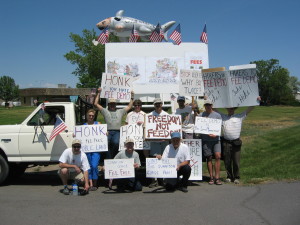For an in-depth analysis of federal recreation fee policies, see
User Fees For Federal Lands: A Failed Experiment
Recreation Fees: A Brief History
1965-1995: The Land and Water Conservation Fund Act of 1965
Under LWCFA, entrance fees were authorized for National Parks, with defined limits, and congressional approval was required for increases. BLM could charge entrance fees for National Conservation Areas. The Forest Service was allowed to charge fees for entrance to National Volcanic Monuments, National Recreation Areas, National Scenic Areas, and National Monuments that are within National Forests. All agencies were allowed to charge fees for use of developed campgrounds, developed swimming sites, and specialized boat launches. Fee revenue (less 15% for administrative expenses) was paid to the U.S. Treasury for appropriation by Congress. Where fees were charged they were modest, stable, and generally well accepted. The vast majority of Forest Service and BLM lands were entirely free of recreation fees.
1996-2004: The Recreational Fee Demonstration Program (Fee Demo)
In 1996, a rider was attached to that year’s must-pass omnibus appropriations bill authorizing the program that came to be known as Fee Demo. Under Fee Demo, the Park Service, Forest Service, Bureau of Land Management and Fish and Wildlife Service were no longer limited on where they could charge fees, and were allowed to keep the revenue instead of paying it to the Treasury. Fee Demo was specifically intended by Congress to raise supplemental revenue to use for backlogged maintenance needs, and was originally authorized as a brief “demonstration” at no more than 100 sites per agency. But Fee Demo was renewed three times-always as an appropriations rider-and ultimately lasted for eight years. The limit of 100 sites was soon removed, and thousands of recreation sites began requiring fees.
American Recreation Coalition
The American Recreation Coalition is the lobbying arm of the commercial recreation industry and proudly claims credit for Fee Demo. These papers describe what ARC wants to see in future recreation fee legislation: Higher fees on more people. Skimpier discounts for seniors and the disabled. More development and technology infrastructure in National Parks and Forests. Special deals for those willing to pay extra. Because, according to ARC, paying fees enhances your experience!
ARC Fee Legislation Outline
Funding for the 21st Century
Connecting people to the outdoors as long as they pay
As local land managers began collecting more and more fees, they saw their appropriated budgets fall. Although congressionally appropriated funding increased, more and more of it was diverted into administrative overhead and local sites began to rely on fees. The “supplemental” revenue that was supposed to help with backlogged maintenance was instead used for routine day-to-day operations. Fees began to be charged for entrance to entire National Forests, driving on scenic roads, use of trails and undeveloped campsites, and for toilets and picnic tables. National Park entrance fees skyrocketed and National Parks began charging additional, layered fees for such things as backcountry permits and interpretive programs.
Fee Demo was unpopular with many public lands users. There were protest rallies, acts of civil disobedience, and negative stories in the media. Grassroots groups opposed to Fee Demo were organized, such as the Western Slope No-Fee Coalition. Resolutions calling for an end to the fees were passed by elected bodies at the State, County, and Local levels, as well as by various Organizations. By 2004, when Fee Demo was scheduled to expire unless renewed again by Congress, it was clear that there were not enough votes to approve another extension, and Fee Demo was set to die a well-deserved death.
2005-Present: The Federal Lands Recreation Enhancement Act (FLREA)
But Fee Demo had powerful supporters, including the American Recreation Coalition and U.S. Representatives Ralph Regula (R-OH) and Richard Pombo (R-CA). Instead of letting Fee Demo end, they pushed a new fee law through Pombo’s House Resources Committee and Regula attached it as a rider to the 2005 Omnibus Appropriations Bill. FLREA repealed Fee Demo and replaced it with a 10-year fee authority for all four of the original agencies plus the Bureau of Reclamation.
FLREA authorizes three types of fees:
- Standard Amenity Fee: Six specific amenities or services must be present in the “area.” The word “area” is not defined and gets stretched to include all the land on either side of scenic roads and huge parcels that contain both developed and undeveloped sites. Many Standard Amenity “areas” contain trailheads that access thousands of acres of backcountry.
- Expanded Amenity Fee: Campgrounds that have five out of nine specific amenities or services, cabin rentals, reservation services, electric/water/cable hookups, RV dump stations, developed swimming sites with specific amenities, and specialized boat launches.
- Special Recreation Permit Fee: The section of the law on SRPs is vaguely worded and open-ended, and they are being used wherever one of the other two types cannot be stretched to fit.
For our survey report on how the provisions of the FLREA that were meant to protect public access are being sidestepped, click here. Have access fees benefited public lands? See for yourself.
The Future: FLREA reached is original sunset date on December 8, 2014 but was extended several times. It is currently authorized through September 30, 2017. Members of both houses of congress have expressed their intent to replace FLREA with reformed recreation fee authority. What that might include is impossible to predict. Some of the bills that have been introduced or presented for discussion would remove the restrictions in FLREA and return to the wide-open authority that failed under Fee Demo. You can follow past and future legislative proposals HERE.
